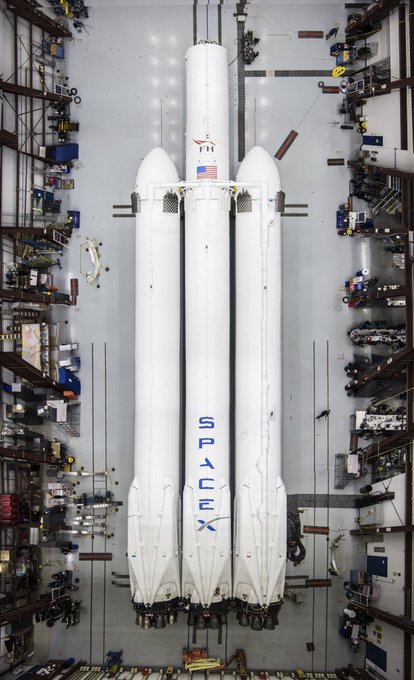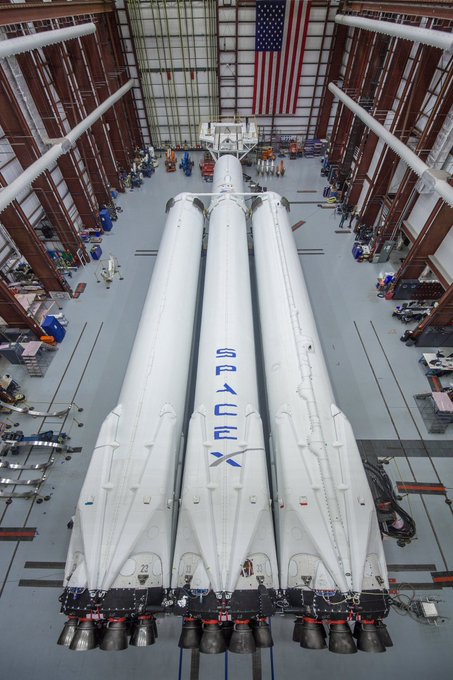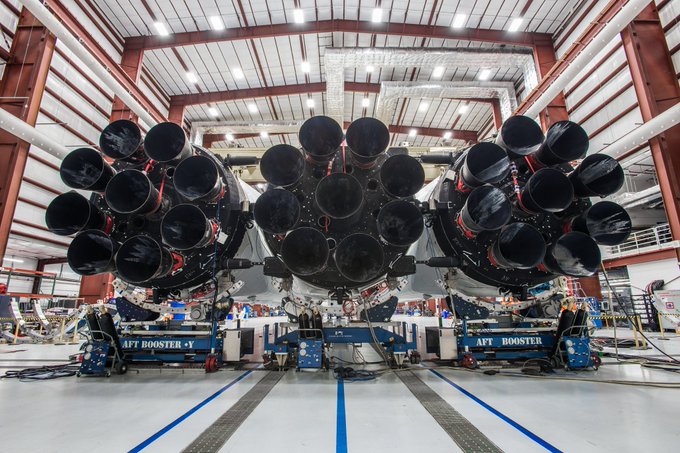As reported by The Verge: Weeks after announcing that he plans to send an original Tesla Roadster to space atop a Falcon Heavy rocket, Elon Musk has released photos of the car being prepped for launch at SpaceX headquarters. The series of photos, posted to Instagram, show the Roadster attached to a fitting and placed between the two halves of the payload fairing that caps the rocket. The photos were posted just hours after a picture leaked on Reddit that showed a grainy view of the car being readied for its final ride.
 This will be the inaugural flight of the Falcon Heavy, a rocket that SpaceX has been planning for years. The successor to the Falcon 9 , it’s essentially (and simply put) three boosters strapped together, all of which will add enough thrust to make it the most powerful rocket in the world. It will give SpaceX the ability to send bigger payloads to space while also helping the company push farther out into the Solar System.
This will be the inaugural flight of the Falcon Heavy, a rocket that SpaceX has been planning for years. The successor to the Falcon 9 , it’s essentially (and simply put) three boosters strapped together, all of which will add enough thrust to make it the most powerful rocket in the world. It will give SpaceX the ability to send bigger payloads to space while also helping the company push farther out into the Solar System.
But SpaceX doesn’t want to put a valuable payload on the very first flight, which even Musk has admitted could end (or begin) with an explosion. So the company plans to use a “dummy payload” instead. “Test flights of new rockets usually contain mass simulators in the form of concrete or steel blocks. That seemed extremely boring,” Musk wrote on Instagram today. “Of course, anything boring is terrible, especially companies, so we decided to send something unusual, something that made us feel.”
In April, Musk said he was trying to think of the “silliest thing we can imagine” to stick on top that first Falcon Heavy rocket. And on December 1st, we learned exactly what that meant. “Payload will be my midnight cherry Tesla Roadster playing Space Oddity,” Musk wrote on Twitter. “Destination is Mars orbit. Will be in deep space for a billion years or so if it doesn’t blow up on ascent.”
After some back and forth about whether he was joking, it became clear that Musk meant what he wrote. And there’s nothing really standing in his way — as long as the car doesn’t impact Mars, there aren’t really any laws blocking the effort.
 This will be the inaugural flight of the Falcon Heavy, a rocket that SpaceX has been planning for years. The successor to the Falcon 9 , it’s essentially (and simply put) three boosters strapped together, all of which will add enough thrust to make it the most powerful rocket in the world. It will give SpaceX the ability to send bigger payloads to space while also helping the company push farther out into the Solar System.
This will be the inaugural flight of the Falcon Heavy, a rocket that SpaceX has been planning for years. The successor to the Falcon 9 , it’s essentially (and simply put) three boosters strapped together, all of which will add enough thrust to make it the most powerful rocket in the world. It will give SpaceX the ability to send bigger payloads to space while also helping the company push farther out into the Solar System.But SpaceX doesn’t want to put a valuable payload on the very first flight, which even Musk has admitted could end (or begin) with an explosion. So the company plans to use a “dummy payload” instead. “Test flights of new rockets usually contain mass simulators in the form of concrete or steel blocks. That seemed extremely boring,” Musk wrote on Instagram today. “Of course, anything boring is terrible, especially companies, so we decided to send something unusual, something that made us feel.”
In April, Musk said he was trying to think of the “silliest thing we can imagine” to stick on top that first Falcon Heavy rocket. And on December 1st, we learned exactly what that meant. “Payload will be my midnight cherry Tesla Roadster playing Space Oddity,” Musk wrote on Twitter. “Destination is Mars orbit. Will be in deep space for a billion years or so if it doesn’t blow up on ascent.”
After some back and forth about whether he was joking, it became clear that Musk meant what he wrote. And there’s nothing really standing in his way — as long as the car doesn’t impact Mars, there aren’t really any laws blocking the effort.
































